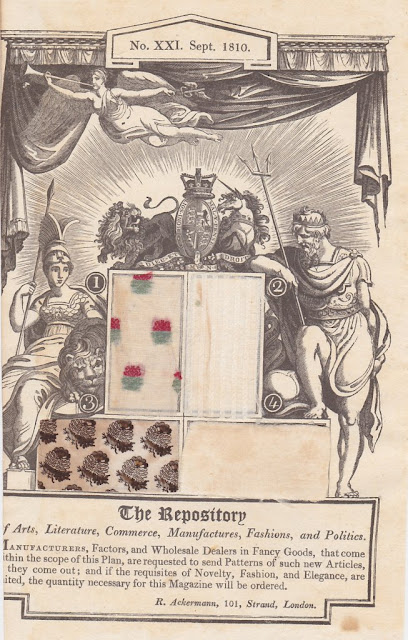As I have in previous posts, I’ll be examining actual fabric samples glued into several earlier editions of Ackermann’s Repository, samples supplied by the manufacturers and published by Ackermann in order to boost the British cloth-making industry at a time when exporting British goods to Europe was almost impossible because of the Napoleonic war. I'll give you a close-up scan of each sample, the published description if available, and my own observations of the color, weight, condition, and similarity to present-day materials, to give you as close a picture as possible of what these fabrics are like.
Today’s four samples are from
the September 1810 issue of Ackermann’s Repository. The overall condition of my
copy is pretty good, with some toning on the fabric samples but not enough to
obscure their details or colors. Here we go!
No. 1. A Cashmire shawl muslin, of agreeably contrasted ground and figure,
adapted for the evening robe or wrap pelisse. The latter worn over a white
sarsnet slip, and embellished with white satin or thread lace; the former worn
quite plain, with a wing collar, and antique cuff of lace. The satin bead,
pearl, or silver filligree ornaments, can only be admitted with lively and
diversified article. It is sold by T. and J. Smith, 43, Tavistock-street,
Covent-garden.
My comments: A finely woven, very lightweight material—the weave is
moderately open, and the fabric has a smooth and silky hand. A dress of this
would definitely require a slip underneath! The red and green pattern, vaguely
floral in this orientation, is woven in.
No. 2. A morine corded cambric muslin, adapted particularly for the
morning robe, Grecian wrap, and children’s frocks and trowsers. This neat and
simply elegant manufacture requires no embellishment, save a simple termination
at its edges, which should either consist of a tambour scallop or narrow
antique lace. It is sold also by T. and J. Smith, as above.
My comments: This is lovely: the ribbing looks almost like a rope
pattern, and lends it a slightly sturdier air though it’s still fairly sheer.
It’s more tightly woven than No. 1, and of finer and more uniform thread
thickness. A morning dress of this would be very graceful and airy, just right
for summer.
No. 3. An Indian shawl cambric, comprising much unobtrusive neatness
and utility. This article exclusively belongs to the simple order of domestic
costume. It is sometimes seen in the high morning robe, but is better suited to
the embroidered shirt and foundling cap of the same, which most agreeably
relieve it. It is sold by Joseph Ord, 77, St. Paul’s Church-yard.
My comments: I am often struck, when I look at the prints from these Ackermann plates, how much they remind me of 1930s prints. This cambric is finely and tightly woven though the hand is not a smooth as expected, and the print crisp and clear under the age-toning spots.
No. 4. A white velvet, of a peculiarly elegant texture, adapted for the
fashionable and beautiful art of velvet painting, now the reigning amusement of
the leisure hours of our elegant females. Chairs, music-stools, screens,
borders for rooms, curtains, and baskets for flowers, are composed of this rich
and attractive specimen of female genius. It is purchased, together with the
colours, and all sorts of paper work, drawings, &c. &c., at Ackermann’s
Repository, No, 101 Strand, at 7s. 6d. per yard.
My comments: Well, well, well—painting on velvet! No images of
Elvis here, though, I presume. The
velvet feels almost like a velveteen, with a very thick, low nap, and rather
stiff (though that could have something to do with how it has aged rather than
the original feel of the fabric.)










No comments:
Post a Comment